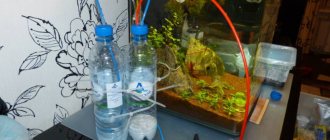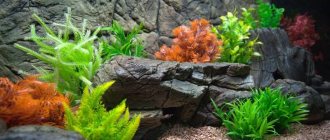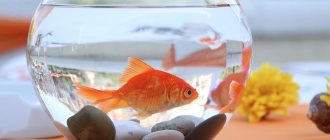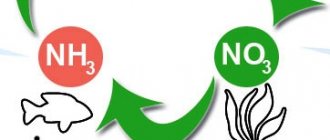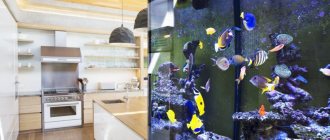Aqua Logo → Supermarket → Useful articles → Aquarium with live plants at your home. Part two
Aqua Logo supermarkets continue to operate! We are open daily. More about the schedule
The first part of the article described the benefits of using live plants instead of artificial ones in an aquarium, and also provided a list of plants suitable for beginners. Next, we will talk about why specialized equipment is required to create a beautiful aquarium with live plants, what exactly needs to be used, and also what aquatic organisms will help decorate a planted aquarium.
Let us remember that plants have been grown in aquariums for more than 150 years - for example, in the seventies of the 19th century, Russian aquarist A.I. Hamburger showed forty specimens of Aponogeton uvirandra at the exhibition, while a wide range of aquarium equipment for planted aquariums is a relatively recent development. Twenty years ago, no one could have imagined that in our time everything would be so automated, maintaining an aquarium through the use of new technologies would become much easier and it would be possible not to go into details and not to design the necessary equipment yourself. It should be remembered: the simple use of expensive equipment is not enough; a correct, well-founded approach and a deep understanding of each process that will be launched to improve the conditions for plant growth are required.
So, to grow “difficult” plants, you need daily fertilizing with fertilizers, the supply of carbon dioxide and a certain acidity/hardness of water. Also, the use of specialized equipment and aquarium chemistry allows you to keep a larger number of plants in the aquarium, i.e. reduce the distance between planting stems and bushes.
Let's take a closer look at the various factors that influence the growth and condition of plants in an aquarium:
Aquarium
The best option for home use is an aquarium made of silicate glass. We recommend purchasing aquariums made from Plexiglas organic glass, which provides additional transparency and creates the feeling of the absence of glass as such. The size factor is also important: it would be optimal to use a low aquarium, with a water column height of up to 60 cm. This height means that light penetrates to the bottom of the aquarium and the plants are illuminated along the entire length. It is better to make the length of the aquarium larger, since for each bush plant you need to have at least 10 square decimeters of area, while the required depth can vary from 30 to 60 cm. Based on the above, a good option would be an aquarium with dimensions: 200 * 50 * 40 ( d*w*h)
How to Grow Lush Green Aquarium Plants
Just as fish people want lush green lawns, they want their aquarium plants to be equally green.
To achieve lush green aquarium plants, use these tips:
- use the right type of fertilizer in the right quantity;
- make sure the plants receive enough light;
- make sure that the aquarium has the correct type of substrate;
- check nutrient levels regularly;
- check the water hardness level.
All of these factors can help you get those lush green aquarium plants that everyone wants to have along with thriving fish.
Priming
In beautiful planted aquariums you cannot do without nutritious soil. Nutrient soil (substrate) is the very first layer of soil that is laid on the thermal cable. I cannot give a definite answer as to what kind of nutrient soil should be used, so I will offer several options to choose from. The progenitor of Russian aquarium hobby N.F. Zolotnitsky, in his book “The Amateur’s Aquarium” (1882), wrote the following: “The soil consists of a mixture of turf soil and peat, to which a little washed river sand is added, applied to the bottom in a layer an inch thick (4.5 cm), and on top of it a layer of thoroughly washed river sand or, even better, gravel is poured almost the same thickness.” In later works on the topic of plant aquariums, for example, Diana Wallstadt also contains advice to use garden soil covered with pebbles or gravel to create a home aquarium with live plants. But in this case, there are many additional problematic factors that need to be taken into account.
The best option would be to use branded nutrient soils Dennerle Deponit Mix, Tetra Plant Complete Substrate, Aquael Acti Substrate, JBL Florapol, JBL ProFloraStart Set, Sera FloreDepot. Whatever the substrate, it must be mixed with clay, or a separate clay layer no more than 0.5 cm thick must be made. Clay has a high ability to retain nutrients and release them to the roots as needed. I recommend adding a layer of gravel on top. The entire soil layer for normal development of the root system and for the formation of necessary bacteria (both aerobic and anaerobic) should be about 8-10 cm
How to care for aquarium plants
Caring for aquarium plants begins with choosing the right plants. You should start by choosing plants that are easy to care for.
Once you select your plants, you need to focus on fertilizer, light, substrate and CO2 levels. Although light is the main source of energy for living aquarium plants, they also require certain nutrients: nitrogen, phosphorus, potassium and trace elements such as iron, manganese and boron.
Proper planting is no less important. If you don't plant them correctly, none of the other factors will matter.
Light
A beautiful and healthy aquarium with live plants requires very powerful light. As practice shows, it is better to have 1-1.5 W/l, taking into account the fact that the aspect ratio of the aquarium is proportional to those indicated above and its depth does not exceed 60 cm. Otherwise, it is necessary to install metal halide lamps. It should be remembered that the wattage per liter of capacity is very relative. If the height of the aquarium is significantly greater than the length and depth, then the above condition cannot be met, because the bottom half of the aquarium will be in semi-darkness. In this case, it would be more correct to calculate the illumination parameter, which is measured in lux (1 Lux = 1 Lumen per square meter), but this calculation is quite complex and it is necessary to take into account a large number of coefficients that you need to know, so it will be easier to rely on the value of 2W /l.
The best option would be to use T5 fluorescent lamps, which have the highest luminous efficiency (i.e., they give off the greatest amount of light from the power consumption). A more budget-friendly option is T8 lamps (necessarily with a metal reflector). Energy-saving light bulbs cannot be used to create a beautiful aquarium with plants, because... they have very low light output with high power consumption.
The power and color temperature of the light flux affect the color of plants and their appearance. For example, a very powerful red light makes it possible to maintain the bright color of young leaves of Echinodorus for a long time, reduces internodes in long-stemmed plants, and increases spreading in rosette plants. You also need to take into account that with such light, green plants may appear red, and dwarf species may stretch out - microranthemum, for example, under metal halide lighting can reach a height of 30 centimeters. I recommend using lamps with peaks in the red (orange-yellow) and violet parts of the spectrum, with a color temperature of 5500 - 6500K.
Daylight hours should last at least 8 hours, and preferably 10-12. And in order to avoid the appearance of algae in the middle of daylight hours, it is necessary to take a lighting break for 1 - 2 hours. Gradually increasing daylight hours increases the likelihood of plants flowering
The right substrate
Plants can grow on any aquatic substrate. However, the optimal condition for them is from 3-5 cm of laterite. Laterite is a combination of rock and soil rich in both aluminum and iron, which is covered by several cm of a wider variety of substrates such as gravel. If for some reason you cannot use laterite, you can provide your plants with fish-safe nutritional supplements such as fertilizers and iron supplements. Your aquatic plants can also benefit from added carbon dioxide. Removing potted plants from the pot and then planting them directly into the substrate is more conducive to plant root development.
Chemical parameters of water
Maintaining the correct water chemistry is an important factor for good plant growth that should not be forgotten. At first glance, it may seem strange to combine plants from different habitats with different chemical and physical parameters of water in one aquarium. But many plants are eurybionts, i.e. organisms capable of adapting to current environmental conditions. And we will talk about creating optimal or weighted average conditions in the aquarium, in which the majority of plants sold on the market today will feel comfortable.
Let's look at the most important chemical parameters of water that every advanced owner of an aquarium with live plants needs to know:
pH – pH indicator
Even from school and chemistry lessons, many remember that if the pH is below 7, then the medium becomes more acidic, if the pH is greater than 7, it is more alkaline, and at a pH equal to 7, the reaction of the medium is neutral. The optimal pH value is in the range from 6.8 to 7.4. The reaction of the medium is alkalized due to water changes (in tap water the pH is usually greater than or equal to 7), as well as by increasing water hardness - baking soda, aragonite and coral chips. But in a planted aquarium there is no need to increase water hardness; it is enough to simply change the standard 15 - 20% of water once a week.
You can acidify the water using the following methods: increase the amount of carbon dioxide, change the water less often, add peat extract or a decoction of alder cones. The most correct option, in our case, is to add CO2.
It is not so important what the pH value in your aquarium will be: 6.8 or 7.4, it is important that there are no significant jumps during the day. If this parameter has fallen or risen above the desired value, then in no case should it be changed in the opposite direction by more than 0.2 per day.
dGH – total water hardness
An indicator of the total content of calcium, magnesium and other salts in water. This value should not exceed 10, or even better 7 degrees, otherwise (with a lack of carbon dioxide) calcium deposits will form on the leaves of the plants, which significantly reduces the aesthetic appeal of the aquarium
dKH – carbonate water hardness or carbonate buffer
Carbonate hardness is an indicator of pH stability, i.e. The higher this indicator, the less likely there is an abrupt change in pH in the aquarium. In this case, the value of kN should not be too large, because this can lead to a loss of pH stability (and the fact that it will begin to increase), as well as to the fact that the content of free carbon dioxide will tend to zero. The recommended dKH value should be 4-5 degrees.
Also interesting is the relationship between carbonate hardness, pH and carbon dioxide ; the optimal values will be as follows: pH/kh/СО2: 6.7/5/32; 6.8/5/25; 6.9/5/20; 7/5/16; 7.1/6/15; 7.2/8/16
Carbon dioxide and aeration
Carbon dioxide is one of the main nutrients for aquarium plants. During the process of growth, during photosynthesis, plants consume carbon dioxide and release oxygen. Carbon dioxide is supplied using homemade or purchased fermentation units, as well as using cylinders. A diffuser is installed in the aquarium, which first accumulates carbon dioxide and then gradually releases it into the water (this is a general case, since there are many options for supplying carbon dioxide to the aquarium). A bubble counter is installed in front of the diffuser, which can be used to control the amount of CO2 entering the aquarium water. Typically the feed rate is 1 bubble per second. It is important to consider that carbon dioxide must be supplied while simultaneously monitoring the pH and kH parameters. You should try to maintain carbonate hardness constant, at least this parameter should not fall below 3 degrees. Carbon dioxide supply controllers are designed for this purpose, which regulate the supply rate depending on the chemical parameters of the water.
At night, when plants stop releasing oxygen and begin to actively breathe, releasing carbon dioxide, it is necessary to turn off the supply, and, conversely, turn on aeration of the water so that the active reaction of the water does not become unacceptably acidic.
Note. When supplying carbon dioxide, there is a need to measure pH and kN in the morning, afternoon, evening and night: during the day there should be no pH jumps of more than 0.3 units, kN jumps of more than 1 unit
Varieties of herbalists
Before moving on to a description of the care of planted aquariums, it is worthwhile to dwell on their varieties, because the care of different types of herbalists will be slightly different.
Based on the speed of growth and development of plants, aquarists distinguish 3 types of herbalists:
- Slow (or not forced)
Aquariums with low plant growth rates. This can be achieved by reducing the level of lighting and doses of applied fertilizers, as well as by refusing to introduce additional carbon dioxide.
- Forced
These aquariums are populated densely and quickly, the flora grows and reproduces intensively. This requires intensified lighting, increased doses of fertilizing and carbon dioxide supply.
- Medium overclocked
Here the average level of growth rates and number of plants. Accordingly, average conditions must be observed here.
According to the inhabitants of herbals, they can be divided into those that are inhabited exclusively by plants without fish and shellfish (plants) and mixed ones, which contain different hydrobionts (underwater flora and fauna). This parameter is also important to take into account: especially in mixed aquariums, in order to achieve a balance of conditions that would suit both plants and fish.
Physical parameters of water:
Temperature
It influences the rate of biochemical processes in organisms: the higher the temperature, the higher the speed of the process. Consequently, as the water temperature in the aquarium increases, more mineral nutrition, carbon dioxide and more powerful light are required. In this regard, we can say that the increase in temperature beyond the 25 degree threshold is not motivated
Flow and transparency
There are different opinions about whether there should be flow in an aquarium that is densely planted. My unequivocal answer is: yes, it should, and here's why. The current mixes all the water layers of the aquarium, equalizing the temperature and other water parameters, both vertically and horizontally; additionally saturates the water with oxygen, mixing the top layer of water with atmospheric air; washes away dead leaves and food residues from the leaves, which is especially important for long-stemmed pinnately-leaved plants. These plants, as well as aquarium mosses, do not tolerate waste on their delicate needle-like leaves, and their appearance immediately becomes less attractive. There is no need to install additional flow pumps; the exhaust pipe of the external flow filter will suffice.
Correction of values
Sometimes the temperature regime gets out of control and requires urgent action by the aquarist.
How to increase?
There are several ways to raise the temperature in the aquarium:
- Change or add warm water. Just drain 20% of the cold water and add warm water. It is better to do this gradually so as not to cause stress to the inhabitants.
- Install powerful lamps . Lamps are a fairly strong source of heat, especially when it comes to incandescent lamps. By installing 3-4 such bulbs above the surface of the water, you can increase the temperature in the aquarium by 3-4°C.
- Use an aquarium heater. The most reliable method that does not cause unnecessary stress for the inhabitants. The device will not only heat the water, but will also maintain the set temperature.
How to downgrade?
In the summer, this problem becomes especially acute, but it also has several solutions:
Using an aquarium air conditioner - chiller.- Homemade cooling device based on a computer cooler.
- Ice and cold water. But you need to be careful, sudden changes are no less dangerous, especially since this method can cool the water too much.
Practical tips on lowering the temperature in the aquarium in the video:
Why do aquarium plants melt?
You might be surprised that aquarium plants can melt, but they certainly can. The type of substrate you use may be to blame, especially if it is sand.
A sandy substrate provides neither nutrient content nor the ability to absorb any nutrients. Without this factor, your plants may look like they are melting.
Sand is also very dense and can suffocate some types of aquarium plants. This is why it is so important to choose the right substrate.
You can also check the light level to make sure it is not too high. This can also cause plants to melt.
What is a filter for?
This is a special device designed to purify water in a container where fish live. This process is called filtration. The device consists of two elements: a turbine head - a pump that pumps water, and a cartridge with cleaning material.
Filtration improves the living conditions of fish, which produce a lot of toxic waste. In nature this is not a problem due to the large volumes of water that either carry away these wastes or dissolve them. But in a small aquarium, the “population density” is significantly increased, which can lead to gradual cloudiness or contamination of the water, and the appearance of unpleasant odors. In addition, it is during purification that the water is saturated with oxygen, without which the fish cannot live for long.
Given the placement, the filter can be:
- interior;
- external;
- canister;
- bottom
You may be advised to add activated carbon to your aquarium. It can indeed be useful in some cases (absorbs heavy metal salts, toxins, dyes and some chemically active elements), but it should only be used for certain situations and only as a cleaning element.
Hardscape
The initial stage of design is the creation of a hardscape, that is, an internal composition using soil, stones, driftwood and other decorations in an aquarium that is not filled with water. Design type – diagonal. The result should be a rocky “island”, offset to the left side and descending towards the right wall.
Tetra Starter Line 54 liter aquarium with Tetronic LED ProLine
We place Jaya stones (dark rock with red veins) at the bottom, breaking large pieces to obtain elements of the desired size. We attach natural driftwood to them using epoxy glue. Further work is possible after the glue has completely hardened. This process takes at least 12 hours.
We attach the driftwood to the stones using epoxy resin.
We pour washed sand along the front wall and add finely crushed stone and gravel for detailing. Behind the stone “island” we pour a small layer of fine lava, which will not only improve water circulation, but will slightly raise the part of the composition where the main part of living plants will be planted.
Washed sand is used in the foreground of the aquarium
On top of the lava we pour the long-acting nutrient substrate Tetra CompleteSubstrate in a layer of about 2 cm. The high content of iron and microelements ensures rapid survival and intensive growth of living plants.
Tetra CompleteSubstrate will provide plants with important nutrients for a long time.
Next, we pour and level the natural neutral soil Tetra ActiveSubstrate in a layer of about 6 cm. It must first be washed to remove dust that settles during transportation. A light and porous substrate promotes rapid root growth and activates the development of beneficial bacteria, which will have a positive effect on establishing biological balance.
Work on the hardscape is complete.
Hardscape is ready. The next step is planting living plants.

